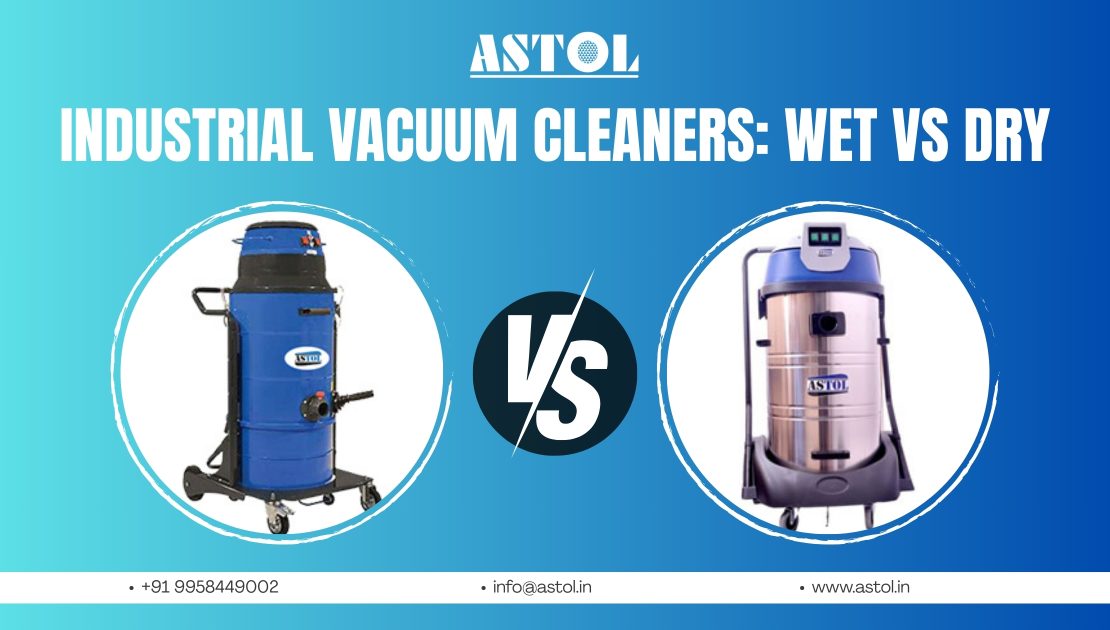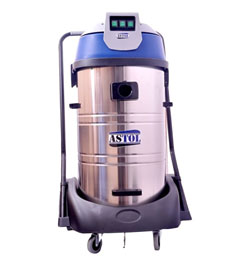The Complete Guide to Industrial Vacuum Cleaners: Wet vs Dry

Industrial Vacuum Cleaners: Wet vs Dry. Every workplace needs cleaning, but when it comes to factories, warehouses, and construction sites, the mess is far bigger than what a normal home vacuum can handle. Dust, fine powder, metal scraps, oil spills, or even chemicals may be lying on the floor. Cleaning them quickly and safely is important for worker health, machine performance, and overall workplace safety.
This is where an Industrial Vacuum Cleaner comes in. Unlike the small machines we use at home, industrial vacuums are built for tough jobs. They are stronger, bigger, and designed to handle both dry dust and wet spills. But here’s the tricky part—there are different types of industrial vacuum cleaners. The two most common are Wet Vacuum Cleaners and Dry Vacuum Cleaners.
In this blog, we’ll break down the differences, their uses, and how to choose the right one for your facility.
What is an Industrial Vacuum Cleaner?
An Industrial Vacuum Cleaner is a heavy-duty cleaning machine used in industries and commercial spaces. Its main job is to suck up dirt, dust, and spills that normal vacuums cannot handle.
Key Features:
- Strong suction power
- Large tank capacity
- Designed for continuous use
- Durable body and parts
- Advanced filters (like HEPA filters) to trap fine particles

These machines are used in factories, warehouses, construction sites, auto workshops, food plants, and chemical industries.
What is a Wet Industrial Vacuum Cleaner?
A Wet Vacuum Cleaner is designed to handle liquids like water, oils, and chemical spills.
How it Works:
- Polluted liquid or wet waste is sucked into the machine.
- It is stored in a special tank.
- A float valve prevents overflow and protects the motor.
Example:
In an auto workshop, oil and water often spill on the floor. A wet vacuum can quickly clean it without damaging the machine.
Best Uses:
- Cleaning oil and water spills
- Factories with chemical leaks
- Kitchens, garages, and car service centers
What is a Dry Industrial Vacuum Cleaner?
A Dry Vacuum Cleaner is designed to pick up solid waste like dust, sawdust, powder, or metal shavings.
How it Works:
- The vacuum pulls in dry particles.
- High-quality filters trap even the smallest dust.
- Clean air is released back into the workspace.
Example:
In a warehouse full of packaging dust and fine powder, a dry vacuum keeps the air clean and the floor dust-free.
Best Uses:
- Factories with dry debris
- Warehouses with packaging dust
- Electronics assembly plants with fine particles
Wet vs Dry Industrial Vacuum Cleaner: Key Differences
Here’s a simple side-by-side comparison:
| Feature | Wet Vacuum Cleaner | Dry Vacuum Cleaner |
| Handles Liquids | ✅ Yes | ❌ No |
| Handles Dust & Solids | ⚠️ Limited | ✅ Yes |
| Filters Needed | Washable, simple filters | HEPA or multi-stage filters |
| Maintenance | Needs cleaning of water tank | Needs regular filter checks |
| Best For | Oil, water, chemical spills | Dust, powder, dry debris |
| Examples | Workshops, kitchens, chemical plants | Warehouses, electronics plants, food factories |
Can One Machine Do Both?
Yes, some industrial vacuums are wet-dry vacuums. These are multipurpose machines that can handle both liquids and solids.
Benefits:
- Saves space and money (no need for two machines).
- Useful for industries that face both spills and dust.
Pros and Cons of Wet Industrial Vacuum Cleaners
Advantages:
- Cleans spills and liquids effectively.
- Prevents accidents from slippery floors.
- Protects machines from damage caused by liquid waste.
Limitations:
- Cannot handle fine dust well.
- The tank needs frequent emptying.
- If not cleaned properly, bacteria can grow inside.
Pros and Cons of Dry Industrial Vacuum Cleaners
Advantages:
- Excellent for fine dust, powder, and dry debris.
- Improves air quality with HEPA filters.
- Easy to maintain.
Limitations:
- Cannot handle liquids.
- May get clogged with sticky substances.
- Filters need regular replacement.
Safety and Maintenance Tips
To keep your industrial vacuum cleaner running smoothly, follow these tips:
- Always use the right vacuum for the right mess.
- Check filters regularly and replace them when needed.
- For wet vacuums, clean and dry the tank after use.
- Inspect hoses and cords to avoid accidents.
- Do not mix liquids and dry waste in the wrong machine.
Which Vacuum is Right for Your Facility?
Choosing the right vacuum depends on your industry:
- Food Processing Facility: Dry vacuum (dust and crumbs)
- Chemical Plant: Wet vacuum (liquid chemical spills)
- Warehouse: Wet-dry vacuum (dust + occasional spills)
- Construction Site: Heavy-duty dry vacuum (cement, sawdust, debris)
- Auto Workshop: Wet vacuum (oil, grease, water)
- Electronics Plant: Dry vacuum with HEPA filters (fine dust, metal fragments)
Conclusion
An Industrial Vacuum Cleaner is more than just a cleaning machine—it’s a tool that protects workers, machines, and the environment.
- Use a Wet Vacuum Cleaner for spills, oils, and chemicals.
- Use a Dry Vacuum Cleaner for dust, powder, and debris.
- Choose a Wet-Dry Vacuum if your facility deals with both.
By matching the right machine to your cleaning needs, you save time, improve safety, and make your workplace more efficient.
FAQs
1. Can a wet vacuum cleaner handle dry waste?
Some wet-dry models can, but wet-only vacuums are not designed for dry dust.
2. Can a dry vacuum cleaner pick up liquids?
No. Using it on liquids can damage the motor and create safety risks.
3. Which vacuum is better for large warehouses?
A wet-dry vacuum is best since it can handle both dust and unexpected spills.
4. Do industrial vacuums need special filters?
Yes, especially for dry vacuums. HEPA filters are important for trapping fine particles.
5. How often should I service an industrial vacuum cleaner?
Basic cleaning after each use is a must. Professional servicing every 6–12 months keeps it in top condition.
